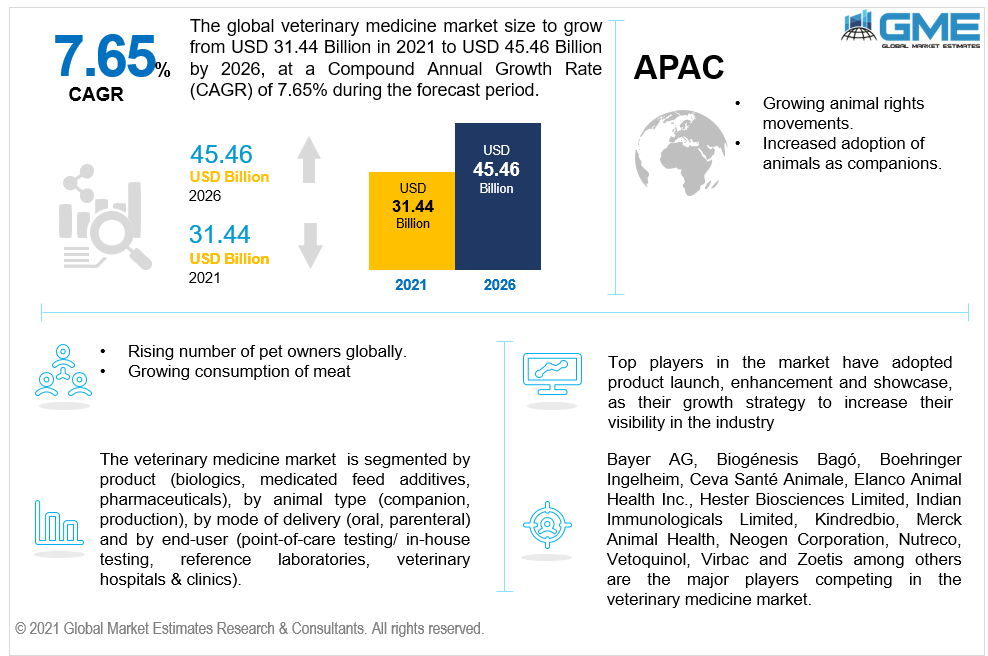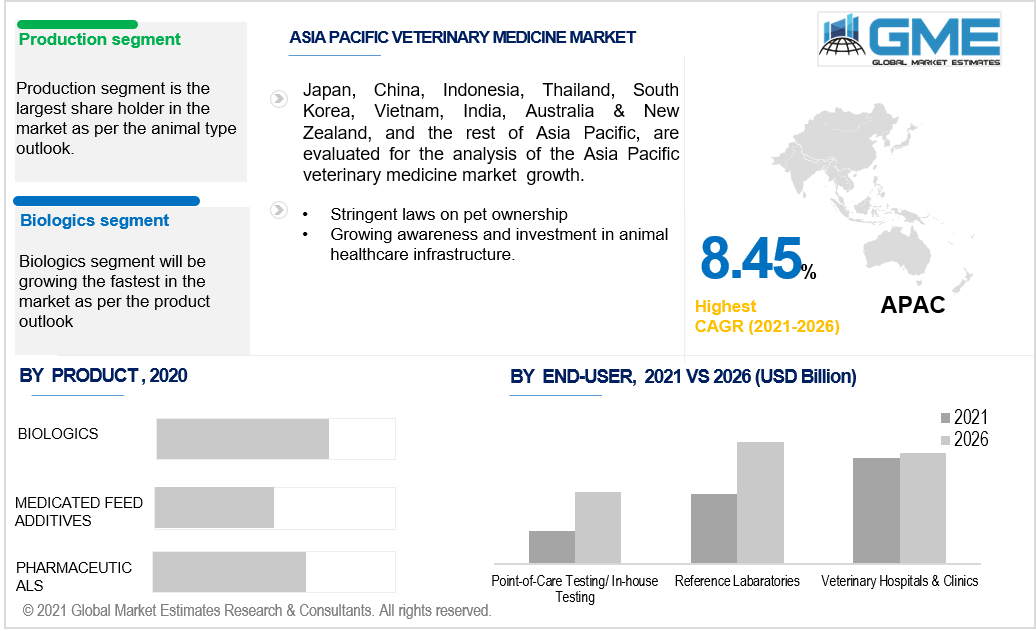
Global Veterinary Medicine Market Size, Trends, and Analysis - Forecasts To 2026 By Product (Biologics (DNA Vaccines, Inactivated Vaccines, Live Attenuated Vaccines, Recombinant Vaccines, Vaccine), Medicated Feed Additives, Pharmaceuticals (Analgesics, Anti-infectives, Anti-inflammatory, Parasiticides)), By Animal Type (Companion (Cats, Dogs, Horses), Production (Cattle, Fish, Poultry, Sheep & Goats, Swine)), By Mode of Delivery (Oral, Parenteral), By End-User (Point-of-care Testing/ In-house Testing, Reference Laboratories, Veterinary Hospitals & Clinics), By Region (North America, Asia Pacific, CSA, Europe, and the Middle East and Africa); End-User Landscape, Company Market Share Analysis & Competitor Analysis
Veterinary medicines are used to improve the quality of life of animals by treating fungal, parasitic, and viral infections. Veterinary medicines also include feed additives that are used to enhance the physical characteristics of livestock and regular vaccinations. The growing adoption of pets in western countries is supporting the market growth. Selective breeding, an increasing number of infectious diseases, stringent laws on pet ownership, and animal welfare is driving the demand for veterinary healthcare services and driving the demand for veterinary medicines across the globe. However, a lack of veterinarians and infrastructure in underdeveloped nations, growing resistance to antibodies, and heavy regulation surrounding feed additives act as restraints to the veterinary medicine market.

By product, the veterinary medicine market can be segmented into pharmaceuticals, biologics, and medicated feed additives among others. DNA vaccines, recombinant vaccines, inactivated vaccines, and live attenuated vaccines are considered under the biological segment. Pharmaceuticals can also be classified into analgesics, anti-infectives, anti-inflammatory, and parasiticides. The pharmaceuticals segment held the largest share of the market owing to the growing number of infections among animals. The biologics segment showed the greatest growth rate as vaccinations are becoming mandatory.
By animal type, the market is considered into companions and production type. Companions are general pets like cats, dogs, and horses while production animals are cattle, fish, poultry, sheep & goat, and swine which are grown for financial gains. The production segment holds the largest market share owing to the growing consumption of poultry and meat globally. The market for companion veterinary medicines has the fastest growth rate among the two.
Veterinary Medicine Market: By End User
Based on the end-user analysis, the market is classified into veterinary clinics & hospitals, hospitals, and reference laboratories among others. Veterinary hospitals & clinics held the largest market share while the reference laboratories segment showed the fastest growth rate. Technological advancements in diagnostics and imaging, surgeries, and other therapeutic services offered in veterinary hospitals and clinics are the major drivers of this segment.

The North American market will be the dominant market while the APAC market showed the highest growth rate. Increasing regulations on pet ownership and the rising number of pet insurance holders are driving regional growth. The European region held the second-largest share of the market and was driven by the stringent regulations in the region. The increasing adoption of animals as companions and the rising awareness of animal healthcare are supporting regional growth.
Kindredbio, Bayer AG, Virbac, Biogénesis Bagó, Zoetis, Boehringer Ingelheim, Vetoquinol, Ceva Santé Animale, Nutreco, Elanco Animal Health Inc., Neogen Corporation, Hester Biosciences Limited, Merck Animal Health, Indian Immunologicals Limited are some of the leading companies in the global veterinary medicines market.
Please note: This is not an exhaustive list of companies profiled in the report.
In January 2021, Vetoquinol acquired the rights for Drontal and Profender de-wormer medicines in the Australian market from Elanco Animal Health Inc.
In 2020, Elanco Animal Health Inc. acquired Bayer Animal Health for USD 7 billion.
We value your investment and offer free customization with every report to fulfil your exact research needs.
The Global Veterinary Medicine Market has been studied from the year 2019 till 2026. However, the CAGR provided in the report is from the year 2021 to 2026. The research methodology involved three stages: Desk research, Primary research, and Analysis & Output from the entire research process.

The desk research involved a robust background study which meant referring to paid and unpaid databases to understand the market dynamics; mapping contracts from press releases; identifying the key players in the market, studying their product portfolio, competition level, annual reports/SEC filings & investor presentations; and learning the demand and supply side analysis for the Veterinary Medicine Market.

The primary research activity included telephonic conversations with more than 50 tier 1 industry consultants, distributors, and end-use product manufacturers.

Finally, based on the above thorough research process, an in-depth analysis was carried out considering the following aspects: market attractiveness, current & future market trends, market share analysis, SWOT analysis of the companies and customer analytics.

Tailor made solutions just for you
80% of our clients seek made-to-order reports. How do you want us to tailor yours?
OUR CLIENTS